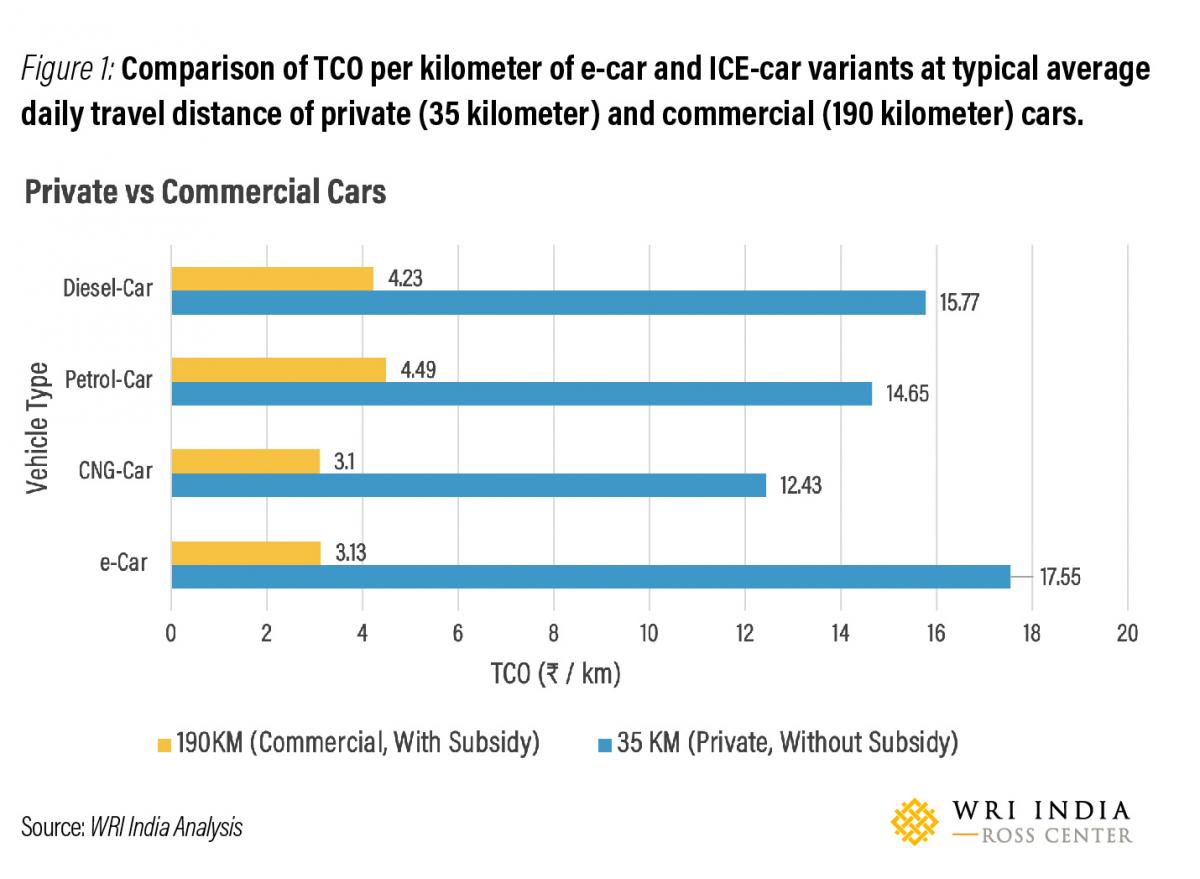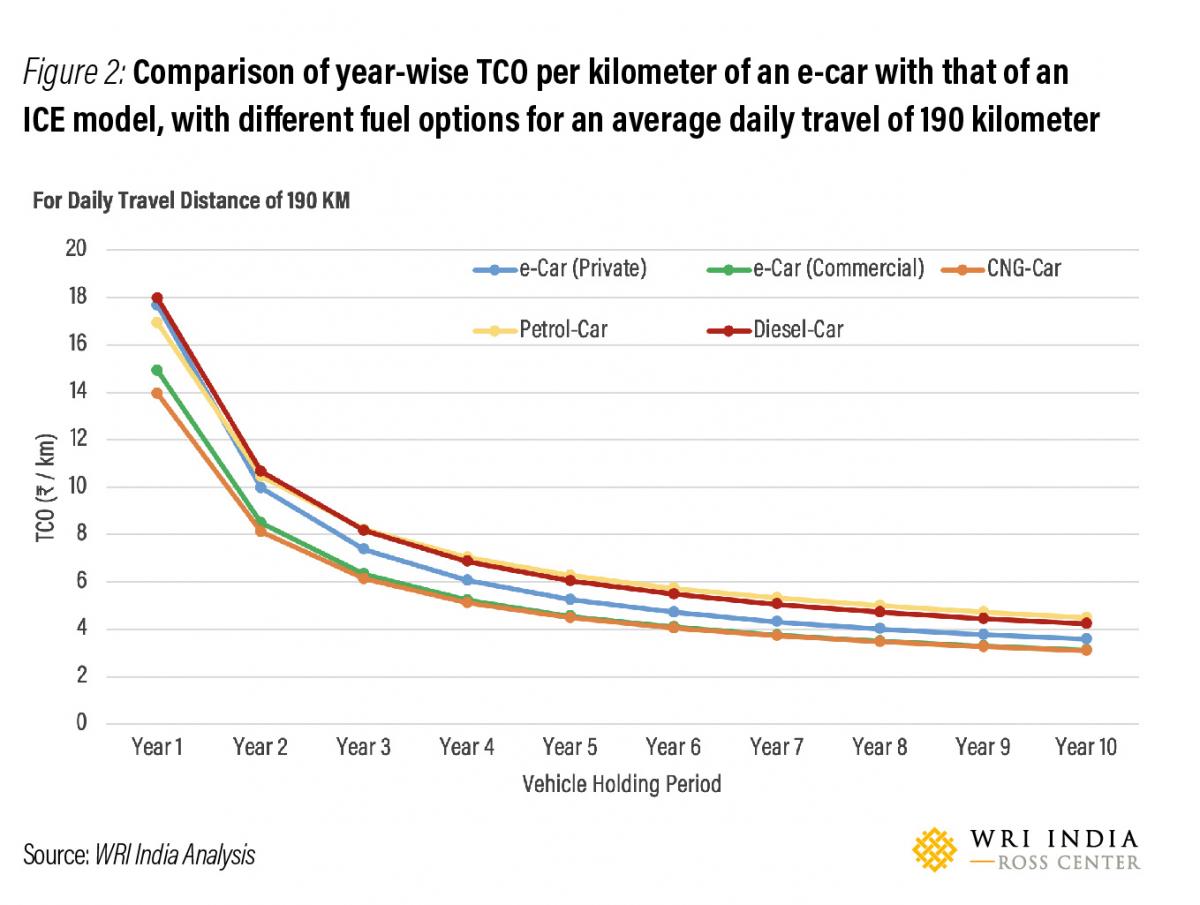Electric car adoption in India: Understanding personal and commercial e-car viability

Globally, the passenger car segment has been the harbinger of the electric mobility shift — chiefly due to its automotive market domination in most countries pursuing transport electrification. While India’s Electric Vehicle (EV) mission has thus far been driven by two-wheelers and three-wheelers, electric car adoption is expected to accelerate in the coming decade.
In this fourth installment of the five-part blog series on the Total Cost of Ownership (TCO) of electric vehicles, we turn our attention to the electrification of cars.
Need for electrification of cars
Car ownership in India has traditionally been very low, but this is slowly changing. Car registrations have grown at over 10% per annum over the past two decades. Between 2007-17, number of cars per 1,000 people has more than doubled from 8.9 cars to about 22 cars. The corresponding ownership rates for urban areas are even higher. According to the vehicle registration data, cities like Bengaluru, Coimbatore, Chandigarh and Delhi have about a 100 cars per 1,000 people
Despite comparatively lower vehicle ownership rates, the negative externalities of rapid motorization continue to impact Indian cities, resulting in high levels of air pollution, traffic congestion and crash-related fatalities. Car travel, due to typically lower occupancy levels, is also associated with higher carbon emissions. With India’s passenger car ownership projected to grow steeply to 175 cars per 1,000 population by 2040, there is a tremendous opportunity to leapfrog over Internal Combustion Engine (ICE) car ownership to electric cars, thereby enabling low-carbon and sustainable transport systems.
Incentives to support the adoption of e-cars
Current policy support for electric cars focuses on commercial and fleet applications. The FAME II scheme offers a purchase subsidy of up to 20% of vehicle value for eligible hybrid and electric cars registered for commercial use. State EV policies also offer capital subsidies and tax exemptions, for commercial and private electric cars. EESL (Energy Efficiency Services Limited), a government joint venture, uses a bulk procurement model to offer competitive EV leases for government car fleets.
Incentives and leasing schemes notwithstanding, the adoption of electric cars has remained stagnant. While overall electric vehicle sales (excluding e-rickshaws) grew at 20% between FY19-20, the sale of electric cars fell marginally during the same period, from 3,600 to 3,400 units. In FY20, e-cars constituted a mere 0.1% of the total number of passenger cars and light commercial vehicles sold.
With the higher upfront costs of EVs cited as a key barrier, economic viability will be crucial for enabling mass adoption of electric cars. A TCO analysis, which accounts for capital and operational costs over the life of a vehicle, offers a useful comparison between EVs and ICEVs to highlight the economic benefits of electric vehicles.
TCO analysis for electric cars
The TCO analysis for electric cars compares TCO per kilometer of a sedan model e-car against ICE variants using petrol, diesel and CNG. The analysis is based on the number of kilometers travelled by a vehicle and its operational life (considered 10 years). Daily travel distances considered for this analysis range from 35 to 190 kilometers per day.

Figure 1 compares TCO per kilometer for different variants, based on vehicle utilization. For personal cars travelling an average distance of 35 kilometers per day, electric cars have a much-higher TCO per kilometer of INR 17.55, compared to INR 15.77 for diesel and INR 14.65 for petrol cars. This difference is partly due to the unavailability of FAME-II subsidy for privately registered e-cars, which drives up their purchase cost significantly.
Considering commercial usage, at a typical distance of 190 kilometers per day, the TCO of an electric car is far more economical than the petrol and diesel variants and is comparable with a CNG-fueled one. In fact, for commercially registered e-cars availing the FAME subsidy, the break-even distance for a competitive TCO per kilometer (against petrol and diesel cars) is as low as 50 kilometers a day, considering the holding period. Road tax exemptions offered by state EV policies (not considered in the analysis) will further heighten e-car advantage for commercial use, while increasing its competitiveness for personal use.

As seen in Figure 2, high daily use of electric cars also results in a more competitive TCO, with e-cars availing FAME-II subsidies (e-car C) being competitive from Year 1 and without subsidy (e-car P), attaining a lower TCO than diesel and petrol cars by Year 2. Thus, even considering a shorter holding period of five years, which is typical for commercial fleets, e-cars are more economical for fleet operations.
Market trends in electric car adoption
The TCO analysis for e-cars dispels the lingering myth that EVs are not economically competitive in the four-wheeler segment. Depending on the car model and its expected daily use, e-cars can be adopted viably for commercial fleet operations.
Lithium and BluSmart are examples of two commercial fleet operators running e-car fleet operations. ICE fleet operators such as Uber and Zoomcar are also experimenting with e-cars through partnerships with Original Equipment Manufacturers (OEMs) like Mahindra Electric and Tata Motors.
For personal use, electric cars are yet to see significant traction due to high TCO, low daily use and lack of FAME-II purchase subsidies.
Looking ahead
With passenger car demand in India expected to remain strong in the coming decades, boosting e-car adoption will have multiple benefits for both, the economy and environment.
For the price conscious Indian market, the TCO analysis points to the need for purchase subsidies to make personal e-car use economically viable. The suppressed growth of e-cars for commercial use shows other critical barriers such as lack of charging infrastructure. Introducing a greater variety of e-cars at different price points, exploring partnerships between fleet operators and charging infrastructure operators, and providing innovative financing models for personal e-cars are some potential solutions to be explored.
This is the fourth blog in our series on TCO analysis of electric vehicles in the Indian market. Our next blog will focus on the findings of the TCO analysis for buses, to demystify the total costs of owning and operating EVs for individuals and fleet operators, analyze the role of financial incentives and vehicle utilization patterns, and highlight specific implications for policy makers and manufacturers.
Views expressed here are the authors’ own.
